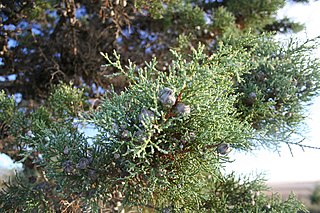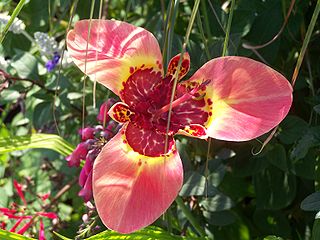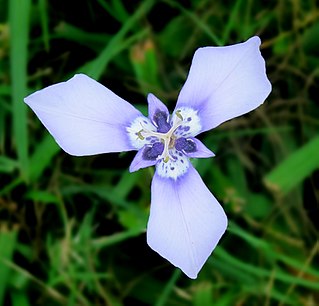
South America is a continent entirely in the Western Hemisphere and mostly in the Southern Hemisphere, with a relatively small portion in the Northern Hemisphere. It can also be described as a southern subcontinent of the Americas. The reference to South America instead of other regions has increased in recent decades due to changing geopolitical dynamics.

Yerba mate or yerba-maté, from Spanish [ˈʝeɾβa ˈmate]; Portuguese: erva-mate, [ˈɛɾvɐ ˈmate] or [ˈɛɾvɐ ˈmatʃɪ]; Guarani: ka'a, IPA: [kaʔa], is a plant species of the holly genus Ilex native to South America. It was named by the French botanist Augustin Saint-Hilaire.

Malbec is a purple grape variety used in making red wine. The grapes tend to have an inky dark color and robust tannins, and are known as one of the six grapes allowed in the blend of red Bordeaux wine. In France, plantations of Malbec are now found primarily in Cahors in South West France, though the grape is grown worldwide. It is increasingly celebrated as an Argentine varietal.

Cypress is a common name for various coniferous trees or shrubs of northern temperate regions that belong to the family Cupressaceae. The word cypress is derived from Old French cipres, which was imported from Latin cypressus, the latinisation of the Greek κυπάρισσος (kyparissos).

Argentina is the fifth largest producer of wine in the world. Argentine wine, as with some aspects of Argentine cuisine, has its roots in Spain. During the Spanish colonization of the Americas, vine cuttings were brought to Santiago del Estero in 1557, and the cultivation of the grape and wine production stretched first to neighboring regions, and then to other parts of the country.

The National Atomic Energy Commission is the Argentine government agency in charge of nuclear energy research and development.

INVAP S.E. is an Argentine company that provides design, integration, construction and delivery of equipment, plants and devices. The company operates in North America, Europe, Asia Pacific, Latin America, the Middle East and Africa, and delivers projects for nuclear, aerospace, chemical, medical, petroleum and governmental sectors.

Rinconsaurus is a genus of titanosaur sauropod dinosaur from the Late Cretaceous in what is now Argentina. The type species, Rinconsaurus caudamirus, was described by Calvo and Riga in 2003, and is based on three partial skeletons.
The electricity sector in Argentina constitutes the third largest power market in Latin America. It relies mostly on thermal generation and hydropower generation (36%). The prevailing natural gas-fired thermal generation is at risk due to the uncertainty about future gas supply.

Tigridieae is a tribe of plants in the subfamily Iridoideae and included in the family Iridaceae. It contains many perennials which have cormous rootstocks. The name of the tribe comes from its main genus - Tigridia. The tribe is native to the New World.

Argentina, officially the Argentine Republic, is a country located mostly in the southern half of South America. Sharing the bulk of the Southern Cone with Chile to the west, the country is also bordered by Bolivia and Paraguay to the north, Brazil to the northeast, Uruguay and the South Atlantic Ocean to the east, and the Drake Passage to the south. With a mainland area of 2,780,400 km2 (1,073,500 sq mi), Argentina is the eighth-largest country in the world, the fourth largest in the Americas, the second largest in South America after Brazil, and the largest Spanish-speaking nation by area. The sovereign state is subdivided into twenty-three provinces and one autonomous city, Buenos Aires, which is the federal capital of the nation as decided by Congress. The provinces and the capital have their own constitutions, but exist under a federal system. Argentina claims sovereignty over part of Antarctica, the Falkland Islands, and South Georgia and the South Sandwich Islands.

Ford Motor Argentina is a subsidiary of Ford Motor Company and was founded in Buenos Aires in 1913. Its first products were Model Ts assembled from complete knock down (CKD) kits provided by Ford Motor Company in 1917. Nevertheless, Ford Motor Argentina is best known in more recent times for producing the Ford Focus and, previously, the Argentine version of the Ford Falcon, originally a U.S. model introduced in Argentina in 1961, but adapted to the Argentine market.

The Revolutionary Communist Party is a Maoist communist party from Argentina.

Cypella is a genus of herbaceous, perennial and bulbous plants in the family Iridaceae. It is distributed in South America, from Peru and Brazil to Northern Argentina. The genus name is likely derived from the Greek word kyphella, meaning "hollow of the ear", and alludes to the shape of the inner tepals.

Herbertia is a small genus of herbaceous, perennial and bulbous plants in the family Iridaceae.

Cipura is a genus of perennial, herbaceous and bulbous plants in the family Iridaceae, related to the genus Cypella. The plants are widely distributed in Mexico, Central, the West Indies, and South America.
Hesperoxiphion is a genus of flowering plants in the family Iridaceae, first described as a genus in 1877. It is native to northwestern South America. The genus name is derived from the Greek words hesperos, meaning "western", and xiphos, meaning "sword".
The Environment of Argentina is characterised by high biodiversity.

Carlo Luigi Spegazzini, in Spanish Carlos Luis Spegazzini, was an Italian-born Argentinian botanist and mycologist.

Phalocallis is a genus of plants in the Iridaceae, first described as a genus in 1839. It contains only one recognized species, Phalocallis coelestis, native to Paraná State in southern Brazil, and also in northeastern Argentina.















